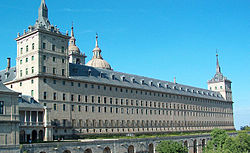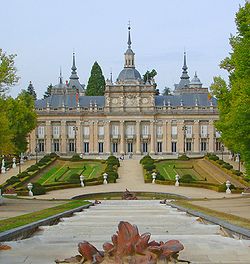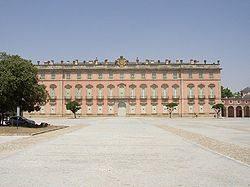| Patrimonio Nacional | |
 The Spanish Royal Crown, symbol of Patrimonio Nacional | |
| Agency overview | |
|---|---|
| Formed | May 12, 1865 (as Crown Heritage) March 7, 1940 (as National Heritage) |
| Preceding agencies |
|
| Type | Autonomous agency |
| Jurisdiction | Spanish government |
| Headquarters | Royal Palace of Madrid |
| Employees | 1.231 (2020) [1] |
| Annual budget | €149 million, 2023 [2] |
| Agency executives |
|
| Parent department | Ministry of the Presidency, Justice and Relations with the Cortes |
| Website | Web Site |





Patrimonio Nacional (English: National Heritage) is a Spanish autonomous agency, under the jurisdiction of the Ministry of the Presidency, Justice and Relations with the Cortes, that administers the sites owned by the Spanish State and used by the Monarch and the royal family as residences and for State ceremonies. The Patrimonio Nacional includes palaces, gardens, monasteries and convents, called the Royal sites. When not in official use, the Royal sites are open to the public. It also manages the official and holiday residences of the Prime Minister.
Contents
- Royal Places
- Royal Palaces
- Royal convents and monasteries
- Residences of the Prime Minister
- Royal Collections Gallery
- The Board
- Structure
- See also
- References
- External links
The agency was first created in 1865 during the reign of Isabella II under the name of Patrimonio de la Corona (English: Heritage of the Crown). During the reign of her grandson, Alfonso XIII, it was also known as Patrimonio Real (English: Royal Heritage). The second republic (1931–1939) kept the agency under the name of Patrimonio de la República ,(English: Heritage of the Republic), and it has been called by its current name since in 1940, when it was renamed Patrimonio National by the dictator Francisco Franco.
Patrimonio Nacional organizes temporary exhibitions and concerts in the Royal sites. It also publishes catalogues of the Royal Collections, books on the Royal sites, facsimiles of some of the books held in the library of El Escorial and the Royal Library, visitors guides to the different sites as well as the official photographs of the King of Spain. It also publishes a quarterly magazine, Reales Sitios, about the art collections and cultural history of the Royal sites.
The Royal Family has other palaces that are not controlled by Patrimonio Nacional.
